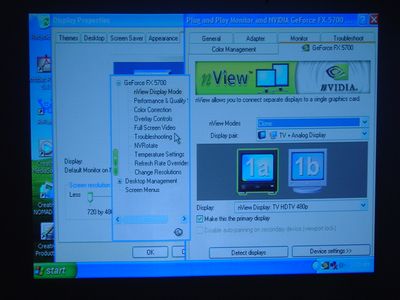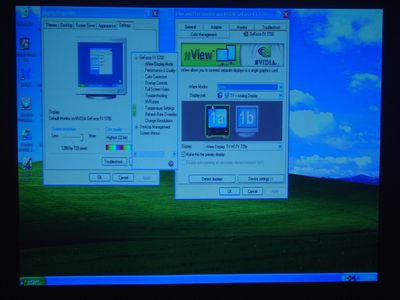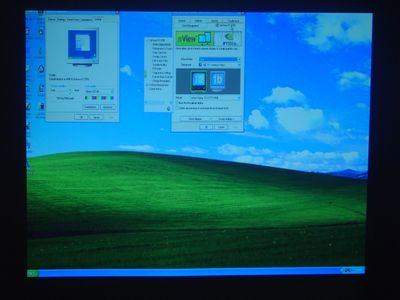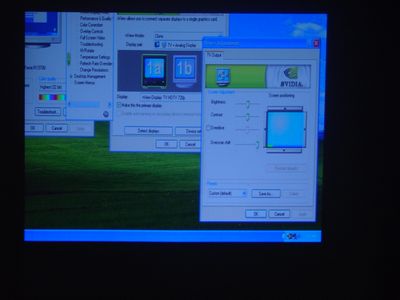eVGA's GeForce FX 5700 Personal Cinema - Nipping at ATI's heels
by Andrew Ku on August 15, 2004 12:05 AM EST- Posted in
- Smartphones
- Mobile
eVGA's GeForce FX 5700 Personal Cinema - HDTV Support
For the purpose of this review, we looked at the native HDTV resolutions on an Infocus X1 projector (pictures come out better from a projector than a HDTV set). We set the TV as the primary desktop and used clone mode, and followed the general directions of "Configuring HDTV" in the release notes of the 56.72 drivers. We should mention that eVGA cautioned us that these drivers must be used with this card, and you shouldn't upgrade to newer display drivers, since the newest WDM drivers are designed to work with this version.Note that you cannot use Window's display properties control panel to manipulate the image needed for TV out. This can only be done in NVIDIA's control panel, since Windows will only indicate that the monitor is hooked up anyways. We set the TV (or HDTV compatible projector, in this case) to primary because we didn't want scaling to occur due to the limitations of our CRT monitor. If the monitor is limited to, say, 1600 x 1200 and we want HDTV set at 1080i, the actual desktop resolution would be 1600 x 900.

@480p (desktop resolution 720 x 480)
Click to enlarge.
At 480p, things were clear and crisp, but we noticed a minimal amount of horizontal and vertical overscan. Note the top, left, and right sides of the photo below. Window's Recycle Bin icon is partially cut off as well as the top of each window open. Horizontally, you can tell that the font for Adobe Acrobat's shortcut on the desktop and the close button on the active window are partially cut off. We would estimate the overscan to be under 5% here for each of the three indicated sides, maybe 1% or 2%.

@720p (desktop resolution 1280 x 720)
Click to enlarge.
Once we move to 720p, we get a similar scenario. However, instead of overscan on the topside of the video source, we get it on the bottom. Note the cut off near the "Start" font of the Start Menu and the bottom space between the clock and the edge of the desktop. If you compare this to the computer you are using right now, you will understand the cut off better. There seems to be a slightly larger degree of cut off here horizontally on each side, though by only maybe 1%.

@1080i (desktop resolution 1920 x 1080)
Click to enlarge.
Now, this is where overscan gets to be a bigger issue. At 1080i, there is even more cut off horizontally and a bit more vertically. Note the cut off where the first vertical row of desktop shortcuts are; this shows horizontal overscan. There is a tad more vertical overscan than 720p, since all of our open display setting windows are not over the edge of the desktop on our monitor, but are when displayed on our projector. And there is a noticeable amount of cut off on our first horizontal row of desktop shortcuts. This combination of overscanning is the most evident in the upper left hand corner of the feed, where the Recycle Bin icon is almost all but cut off.

@720p (desktop resolution 1280 x 720) with NVIDIA's overscan shift on high
Click to enlarge.
NVIDIA's fix for this is something called overscan shift, where they enabled something similar to how Windows handles resolutions larger than what the monitor can support (the newer plug and play monitors), called Windows virtual desktop. By increasing the overscan shift setting, the larger the area that you are allowed to scroll to by your mouse also increases. In this picture, we set the overscan shift value to its maximum and scrolled to the lower right hand corner. This surface area of the projector screen shot is the same as in the earlier photo of 720p. So, if you compare the two, you can see the black space that NVIDIA adds while you increase the overscan shift value too much and there is no overscan to compensate for in those areas.
For your information, we are hoping that we can get around to comparing HDTV on NVIDIA and ATI cards one of these days, when we settle a few things on the "how do we compare...?"
eVGA's GeForce FX 5700 Personal Cinema – The Card (cont.)
eVGA's GeForce FX 5700 Personal Cinema – The Software










10 Comments
View All Comments
AndrewKu - Wednesday, August 18, 2004 - link
#8 - That is very interesting... In theory, it shouldn't do anything; could be some fluke thing with the driver or possibly optical illusion. I will look into it later...glennpratt - Wednesday, August 18, 2004 - link
Well I've used it on my HDTV to make the image smaller, which in effect gets rid of overscan. I'm using VGA to RGBHV adapter as opposed to YPrPb so it may be different for me.AndrewKu - Monday, August 16, 2004 - link
#2- Are you sure you mean NVKeystone? That has no bearing on overscan. Anyways that is mainly for notebooks outputing a video source to something like a projector in native computer resolutions, not HDTV ones.glennpratt - Monday, August 16, 2004 - link
No answer?nullpointerus - Monday, August 16, 2004 - link
A 10 ft. UI means that the interface is clear enough to see and use on a TV screen that is approximately 10 ft. from the viewer. That's important if you are setting up a home theater PC (HTPC) with a remote, for example.AndrewKu - Monday, August 16, 2004 - link
#3 - Yes that is what it means. My apologies for not clarifying.jediknight - Monday, August 16, 2004 - link
>> 10 ft. UI <<This is mentioned several times in the article, and I have no clue what this means.
Sounds to me like ten feet user interface??!
glennpratt - Sunday, August 15, 2004 - link
Did you try using NVKeystone to fix the overscan? Is that not available on HD out? Make sure you hit the lock Icon then just make it smaller.thatsright - Sunday, August 15, 2004 - link
WOW! I'm really tired!recyclingmetal - Monday, February 28, 2022 - link
Consumer products make up the last scrap that gets recycled. Items like Aluminium window frames are looked after, shredded, https://botanyscrapmetal.net/scrap-metal/ wiped clean and melted earlier than putting off all via-merchandise. At this factor, one of a kind alloys may be added to the Aluminium, developing an nearly-actual pastime of primary Aluminium.